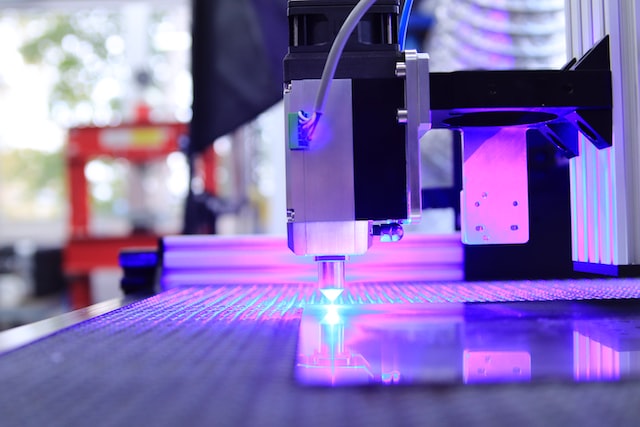The 3D Printing industry comprises companies offering products and services capable of manufacturing a wide range of products. 3D Printing, also known as additive manufacturing, manufactures three-dimensional objects from digital designs, and the technology can revolutionize manufacturing by allowing customized products to be produced on demand.
To print, thin layers of material—such as liquid or powdered plastic, metal, or cement—are laid down, and then the layers are fused. 3D is a ground-breaking technology that has the potential to upend the manufacturing logistics and inventory management sectors, despite being still too slow for large production. Only a small number of businesses operate in the 3D printing sector, including Proto Labs Inc., Faro Technologies Inc., and Desktop Metal Inc.
Since the industry is so new, there is no helpful benchmark index. However, comparing the performance of these stocks with the larger market, Stratasys Ltd. (SSYS) has significantly lagged behind the Russell 1000, which has generated a total return of -1.6% over the last 12 months.
3D printing is revolutionizing multiple industries
 3D potential technology has created opportunities for many industries like medical, automotive, aerospace, construction, and consumer goods.
3D potential technology has created opportunities for many industries like medical, automotive, aerospace, construction, and consumer goods.
Medical: 3D technology has taken off medical treatment and surgery. Surgeons can now use 3D-printed models of human organs to plan and practice surgery. 3D bioprinting technology contributes to creating living human cells. During the pandemic, the 3D industry began 3D-printable-open-source (PPE) equipment to ease the equipment shortage.
Automotive: A B2B research company called Markets and Markets predicts the automotive 3D printing market to increase from $2.9 billion in 2022 to $7.9 billion in 2027. The pandemic revealed a need for a solution to reduce supply chain disruptions and decrease development time, which 3D printing can assist. The demand for electric vehicles has raised the need for lightweight components, which 3D printing makes readily available. This industry has fueled significant investments made by original equipment manufacturers.
Aerospace: According to Allied Industry Research prediction, the global aerospace 3D printing market will grow from $1.4 billion in 2020 to $6.8 billion by 2030, or more than 18% annually. Increased demand for lightweight aviation components and more straightforward prototyping has fueled the growth. Despite the high cost of 3D printing and the additional burden of regulatory control in the aerospace sector, industry insiders claim they are dedicated to creating new supply chains and procedures.
Construction: Customized building components, such as door frames, window casings, and roofing tiles, have been printed using 3D printing technology to speed up construction.
Consumer goods: Companies use 3D printing technology to create custom-fit garments and accessories. 3D printers also play a part in making furniture and other home furnishings.
Best 3D printing stocks for 2022
The top three 3D printing stocks with the best performance, value, and sales growth are listed below. Every statistic below, including this market performance number, is current as of June 2, 2022.
- Stratasys Ltd (SSYS)
Price ($): 20.48
Market Cap ($B): 1.4
12-Month Trailing P/S Ratio: 2.1
Stratasys also provides 3D printing solutions in addition to 3D printers, polymer materials, a software environment, and related parts. It supports numerous sectors, including consumer goods, healthcare, aerospace, and NASCAR announced their collaboration on May 31. Stratasys announced that it has collaborated with NASCAR to manufacture the first 3D-printed parts to be used in all NASCAR Next Gen race vehicles, which will start participating this year. These parts include a ventilation unit for the cockpit's windshield air.
- Proto Labs Inc (PRLB)
Price ($): 49.46
Market Cap ($B): 1.4
12-Month Trailing P/S Ratio: 2.8
Proto Labs, an e-commerce-based company, offers digital manufacturing services. It provides sheet metal fabrication, CNC machining, 3D printing, and injection molding. Proto Labs released Q1 2022 statistics on May 6; they showed a 37.3% increase in net income and a 6.9% increase in revenue year over year (YOY). By reporting a 78.6% increase in sales year over year, Hubs, the online manufacturing platform that Proto Labs obtained in January 2021, contributed to growth.
- Desktop Metal Inc.
Price ($): 2.17
Market Cap ($B): 0.7
Revenue growth (%): 286.3
Desktop Metal builds 3D printers and accompanying equipment to manufacture sophisticated metal items. It also provides software for 3D printing. The company provides services to numerous sectors, including heavy industry, consumer goods, automotive, and education. On June 3, Desktop Metal announced that ExOne, a subsidiary of Desktop Metal, will collaborate with Concurrent Technologies Corp. on a project for the United States Defense Logistics Agency. In a $15 million effort, the two businesses will create 3D-printed sand casting mold technology.
The 3D printing ETF
 Returns annualised (as of July 19, 2022): -38.8% (1 year), -0.8% (3 years), and -2.5% (5 year)
Returns annualised (as of July 19, 2022): -38.8% (1 year), -0.8% (3 years), and -2.5% (5 year)
Expense ratio: 0.66%
The advisory company of investor Cathie Wood, ARK Invest, is in charge of managing the 3D Printing ETF (PRNT). The fund tracks 50 3D printing companies, including hardware, software, scanners, materials, and printing facilities. Microsoft, Autodesk, Xometry, and PTC are a few well-known companies that hold stock.
The fund follows a weighted, tier-based index.
The fund has extensive direct and indirect exposure to the total 3D printing market. PTC, one of the fund's assets, is predominantly involved in 3D technology, whereas Microsoft, another significant position, has broader business lines.
The ETF might be a practical and reasonably priced option to invest in the 3D market for individuals who find it to be an appealing sector without having to conduct in-depth research on individual businesses.
The future of 3D printing
The future of 3D printing has a lot of latent potentials, but some degree of uncertainty tempers this overall optimistic perspective. 3D printing has gained popularity as a cutting-edge technology that extends beyond the printing sector. One thing is sure, though: as time goes on, technology will only get more pervasive and advanced.
In conclusion, 3D printing has undoubtedly established a reputation for itself and is not showing any indications of slowing down. As a result, it is an attractive sector for investors to consider for their portfolios.



